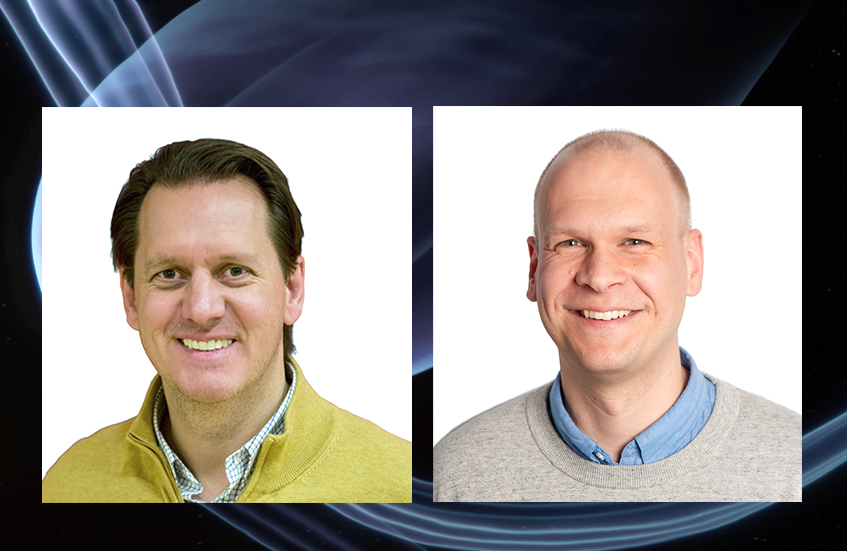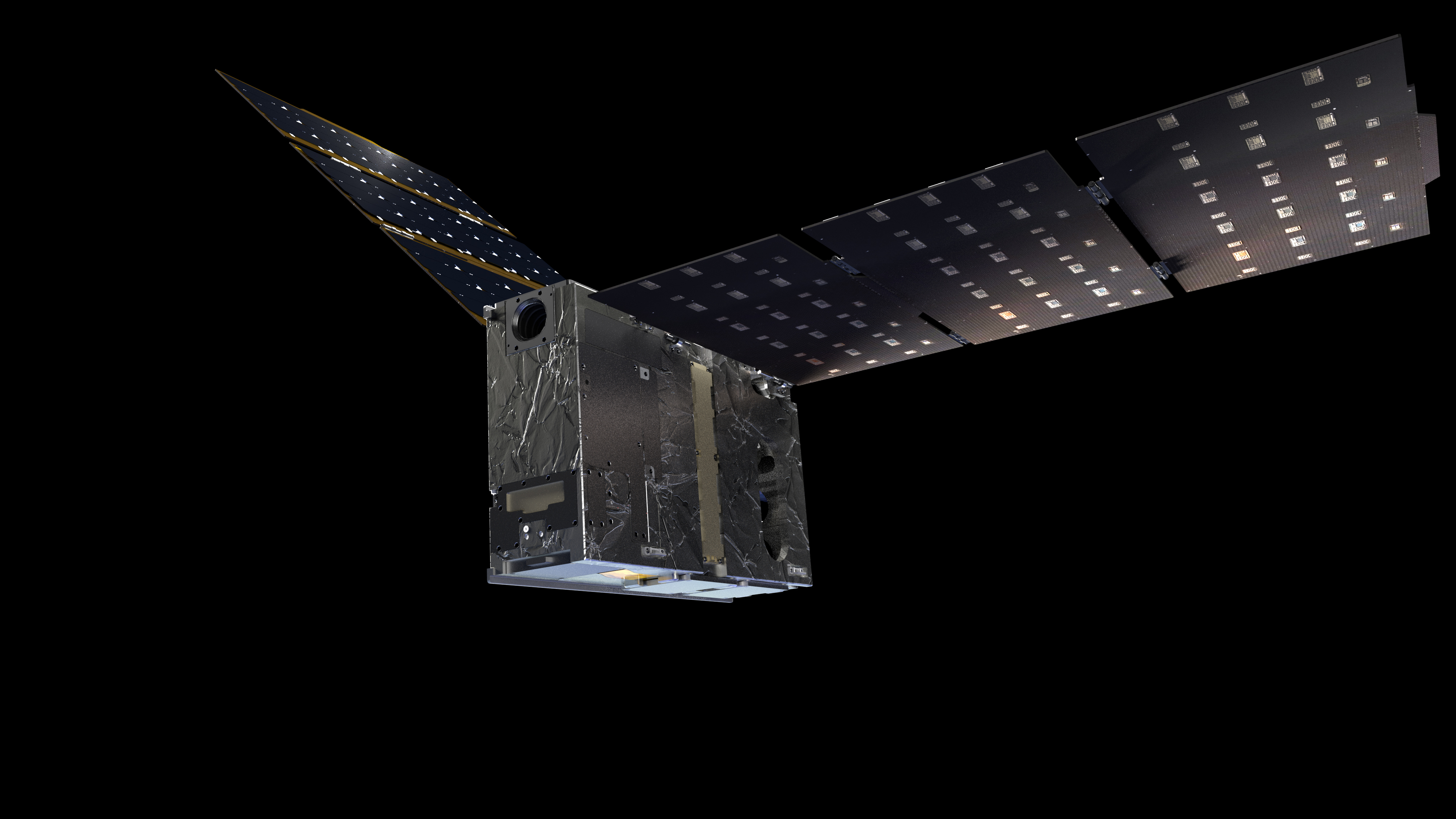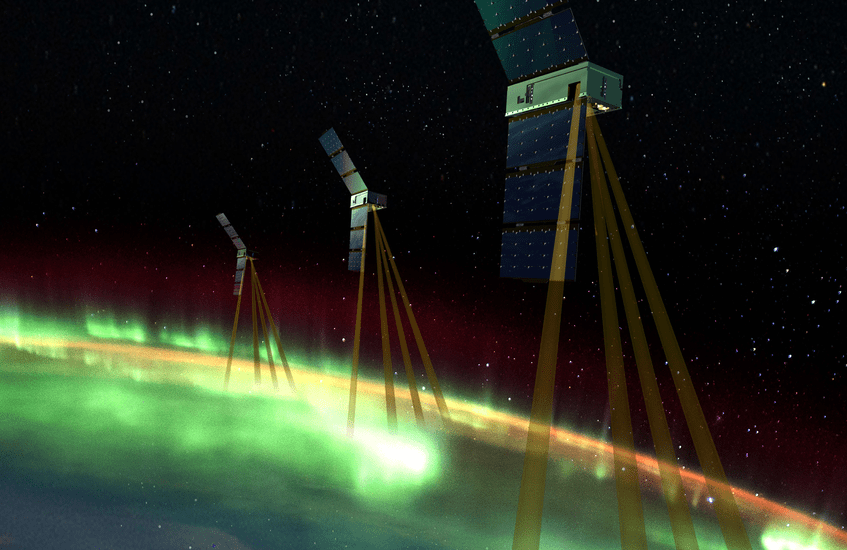Artist’s conception of the EZIE mission. EZIE consists of three SmallSats that will study the auroral electrojet, which are electrical currents flowing above the poles that link the beautiful aurora to the Earth’s magnetosphere, and which responds to solar activity and other drivers. Credit: NASA/Johns Hopkins APL
Link to Press Release in Norwegian
Scientists at BCSS are central in a new and exciting NASA mission. In a press release from 29 December 2020, NASA announced that the EZIE mission is selected to study electric currents in Earth’s atmosphere linking aurora to the Earth’s magnetosphere. Link to the NASA press release.

Professor II Jesper Gjerloev (left) and research group Leader Karl Magnus Laundal.
Understanding the Auroral Electrojets is of Universal Importance
“The spectacular aurora is the visual evidence of the constant interactions between Earth and the surrounding space. Key to these interactions are electrical currents which flow from vast distances and close in the upper atmosphere”, Jesper Gjerloev says. “Despite decades of research, we still don’t understand basic configuration of this dynamic current circuit. We simply don’t know the basic physics that takes place in our own backyard. This is a problem of universal importance since it applies to any magnetized body such as Mercury, Saturn and Jupiter and it also has practical importance for Earth since these currents have profound impact on our ever-increasing dependence on technological systems”.
The Purpose of EZIE
The purpose of EZIE (Electrojet Zeeman Imaging Explorer) is to reveal the structure and evolution of electrojets – a critical component of the vast electrical current system coupling the magnetosphere to the ionosphere and atmosphere. More specifically, the three questions to be resolved are as follows:
- What is the structure and evolution of the auroral electrojet segment of the substorm current wedge?
- To what extent is the auroral electrojet modulated by localized (hundreds of kilometers) current segments?
- What are the key characteristics of the equatorial electrojet dynamics (2-20 min) and mesoscale (150-500 km) longitudinal structure?
The Zeeman effect
EZIE is profoundly innovative. The mission is a rare, fortuitous coincidence of a new, innovative, and compact sensor technology and the recent emergence of high-heritage CubeSats enabling simultaneous multipoint measurements that together provide an extremely cost-effective solution to NASA priorities (e.g. space weather).
EZIE will make observations of the auroral electrojets in a completely new way, using the Zeeman effect: “The Zeeman effect has only been used for astronomical applications, as far as I know, and not for terrestrial magnetic fields” Karl Magnus Laundal explains. “It’s a very challenging measurement to make and to use, because it is more noisy than traditional magnetometer measurements. The advantage is that we cover a much larger area in a shorter time, and that our measurements come from an altitude which is much closer to the electrojet than traditional measurements which come from ground or from low Earth orbit. We will essentially take pictures of the magnetic field disturbances, and calculate the associated electrojet. We will resolve finer scales than what has been possible before, which is pretty remarkable, considering that the electrojet has been studied in detail since Kristian Birkeland’s pioneering work ~120 years ago”.

Artist’s impression of an EZIE SmallSat. Credit: NASA/Johns Hopkins APL/Steve Gribben
Budget and launch date
The NASA budget for the EZIE mission is $53.3 million (or 450 million NOK), and the launch is no earlier than June 2024. “It’s a lot of money, but for a space mission it is quite cheap ” Laundal says. “The three EZIE satellites are small, and will not carry any other major instruments than the Zeeman magnetic field sensor. It will be a piggyback launch, which means that it will launch on a rocket that carries another primary payload”.
How the EZIE mission started
Karl Magnus Laundal explains that the idea for the mission was developed after the PI (Sam Yee), Jesper Gjerloev and others, demonstrated that the Zeeman effect can be used to measure magnetic field disturbances in the mesosphere, using an existing instrument in space, on the AURA satellite. Here is a link to their paper entitled “First Application of the Zeeman Technique to Remotely Measure Auroral Electrojet Intensity From Space”.
“I got involved not long after that paper was published” Laundal says. “I am the lead for the derivation of the electrical currents and proved that the mission can produce current maps that allow us to answer the science questions. Our proposal was one of three that were selected for phase A (in September 2019). Two of the three have now been selected for flight”.
Roles in project
Jesper Gjerloev is a professor II at BCSS. He is also the Project Scientist for the EZIE mission, which he leads together with PI Sam Yee at APL, Johns Hopkins University. Karl Magnus Laundal is Co-I and Lead for Current Inversions.
About his own role in the project, Laundal tells: “I am responsible for using the observations to derive 2D maps of the electrojet. I have developed algorithms to do this, and it is described in a paper that is currently in revision. The preprint is available here – much of the material in this paper was used in the proposal and the concept study report. My PhD student Michael Madelaire, and postdoc Jone Reistad (both BCSS members) were also involved in the work on that paper”.
Also involved in the EZIE science team is professor Patrick Espy at NTNU: “As a member of the BSCC team examining the effect of particle precipitation on the neutral atmosphere, my role as a collaborator with EZIE will be to quantify and interpret perturbations of the electrojet system caused by wind and waves in the neutral-atmosphere”, Espy says.




